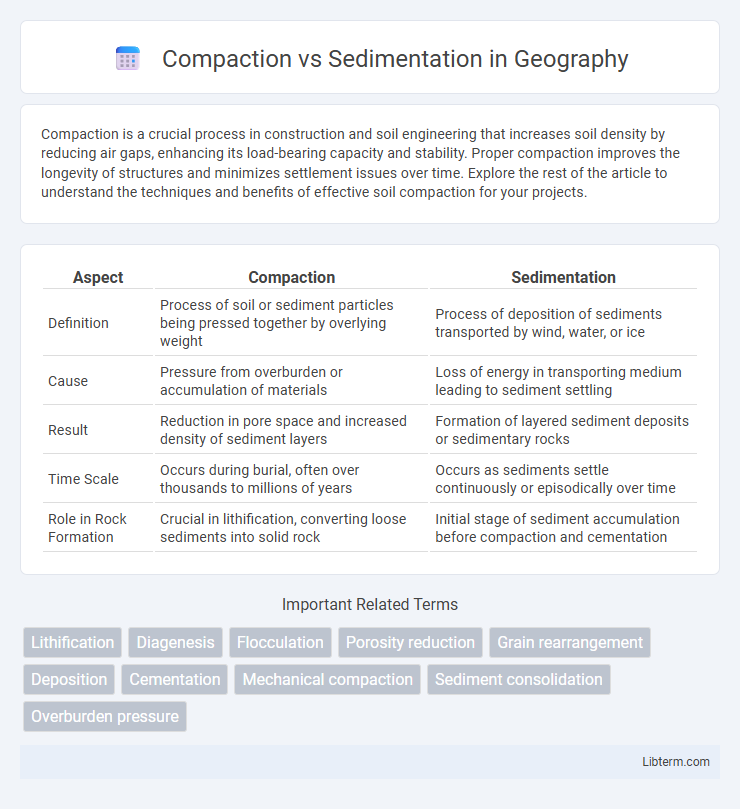Compaction is a crucial process in construction and soil engineering that increases soil density by reducing air gaps, enhancing its load-bearing capacity and stability. Proper compaction improves the longevity of structures and minimizes settlement issues over time. Explore the rest of the article to understand the techniques and benefits of effective soil compaction for your projects.
Table of Comparison
| Aspect | Compaction | Sedimentation |
|---|---|---|
| Definition | Process of soil or sediment particles being pressed together by overlying weight | Process of deposition of sediments transported by wind, water, or ice |
| Cause | Pressure from overburden or accumulation of materials | Loss of energy in transporting medium leading to sediment settling |
| Result | Reduction in pore space and increased density of sediment layers | Formation of layered sediment deposits or sedimentary rocks |
| Time Scale | Occurs during burial, often over thousands to millions of years | Occurs as sediments settle continuously or episodically over time |
| Role in Rock Formation | Crucial in lithification, converting loose sediments into solid rock | Initial stage of sediment accumulation before compaction and cementation |
Understanding Compaction and Sedimentation
Compaction reduces sediment volume by squeezing out water and air due to the weight of overlying deposits, increasing sediment density and decreasing porosity. Sedimentation involves the settling of suspended particles in water or air, leading to the accumulation of sediment layers over time. Understanding these processes is crucial for interpreting sedimentary rock formation and soil stability in geological studies.
Definition of Compaction
Compaction is the process where sediment grains are pressed together under pressure, reducing pore space and expelling water to form denser sedimentary rock. This physical deformation occurs after sediment deposition and is a key early stage in lithification. Unlike sedimentation, which involves the settling of particles from suspension, compaction primarily modifies the sediment's internal structure through pressure.
Definition of Sedimentation
Sedimentation is the process by which suspended particles in a liquid settle out of the fluid and accumulate as a sediment, driven mainly by gravity. This natural phenomenon separates solids from liquids by allowing particles to concentrate at the bottom of a container or body of water. Unlike compaction, which involves compressing sediments under pressure to reduce their volume, sedimentation relies on particle settling for separation.
Key Differences Between Compaction and Sedimentation
Compaction reduces soil volume by pressing particles closer together, primarily through the application of mechanical force, while sedimentation involves the settling of particles from a fluid due to gravity. Compaction increases soil density and strength, making it essential for construction and foundation stability, whereas sedimentation forms layered deposits in water bodies, influencing sedimentary rock formation and aquatic habitats. The primary difference lies in the processes: compaction is a physical densification of solids, and sedimentation is the gravitational settling of particles suspended in a fluid.
Processes Involved in Compaction
Compaction involves the process of sediment grains being pressed together under the weight of overlying materials, reducing pore space and expelling water. This decrease in porosity increases sediment density and contributes to lithification. Mechanical compaction primarily affects coarse-grained sediments, while chemical compaction involves pressure solution at grain contacts.
Processes Involved in Sedimentation
Sedimentation involves the process where suspended particles settle out of a fluid due to gravity, forming sediment layers over time. This natural process includes flocculation, where fine particles aggregate into larger clumps, enhancing sedimentation rates. Sedimentation tanks and basins are engineered to optimize particle settling by controlling flow velocities and residence time, critical for water and wastewater treatment.
Importance in Geological Formations
Compaction and sedimentation are critical processes in geological formations that influence rock porosity and stratification. Sedimentation layers sediments, creating depositional environments essential for fossil preservation and reservoir rock development. Compaction reduces pore space between sediment grains, enhancing rock density and stability, which is vital for petroleum reservoirs and groundwater aquifers.
Applications in Engineering and Construction
Compaction increases soil density by mechanically pressing particles together, enhancing load-bearing capacity essential for stable foundations and road construction. Sedimentation involves the settling of suspended particles in fluids, critical for designing sediment control in hydraulic engineering projects such as reservoirs and wastewater treatment plants. Both processes help optimize soil and sediment management to improve structural integrity and environmental sustainability in construction.
Environmental Impacts of Compaction and Sedimentation
Compaction reduces soil porosity, leading to decreased water infiltration and increased surface runoff, which accelerates erosion and nutrient loss, negatively impacting terrestrial and aquatic ecosystems. Sedimentation results in the accumulation of sediments in water bodies, causing habitat degradation, reduced water quality, and altered aquatic habitats, threatening biodiversity and ecosystem services. Both processes disrupt natural soil and water dynamics, contributing to long-term environmental degradation.
Summary of Compaction vs Sedimentation
Compaction reduces soil volume by expelling air and water from pore spaces due to applied pressure, increasing soil density and stability. Sedimentation involves the settling and accumulation of suspended particles in a fluid, forming sediment layers over time. While compaction improves soil strength and reduces permeability, sedimentation primarily influences layer deposition and landscape formation.
Compaction Infographic

 libterm.com
libterm.com